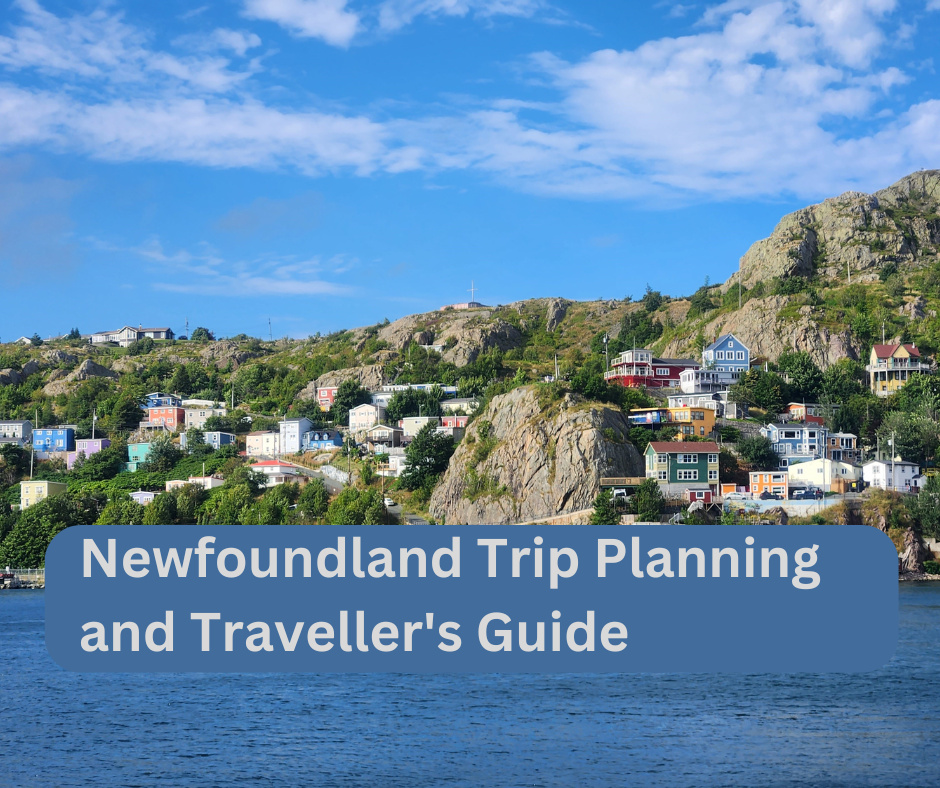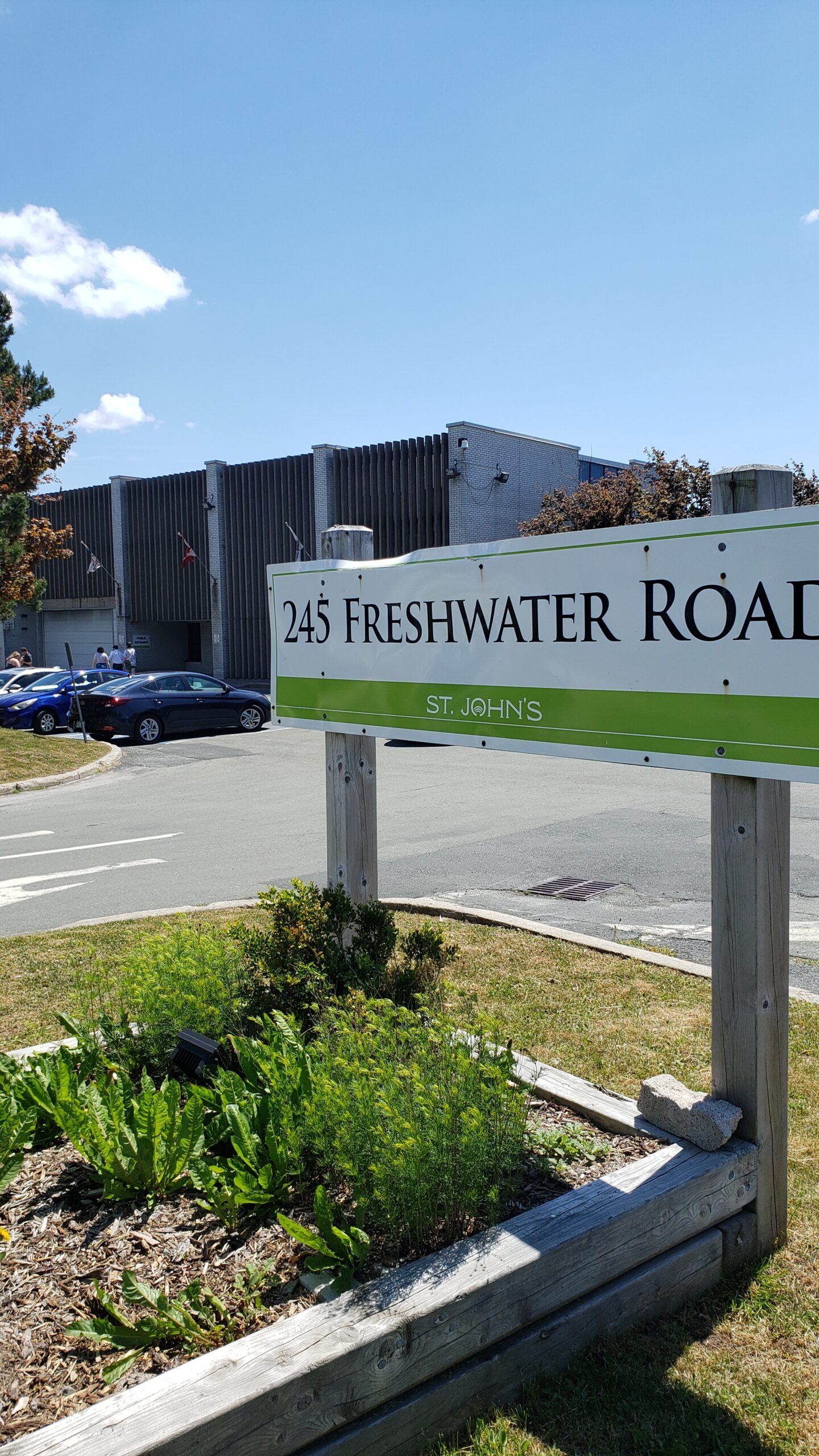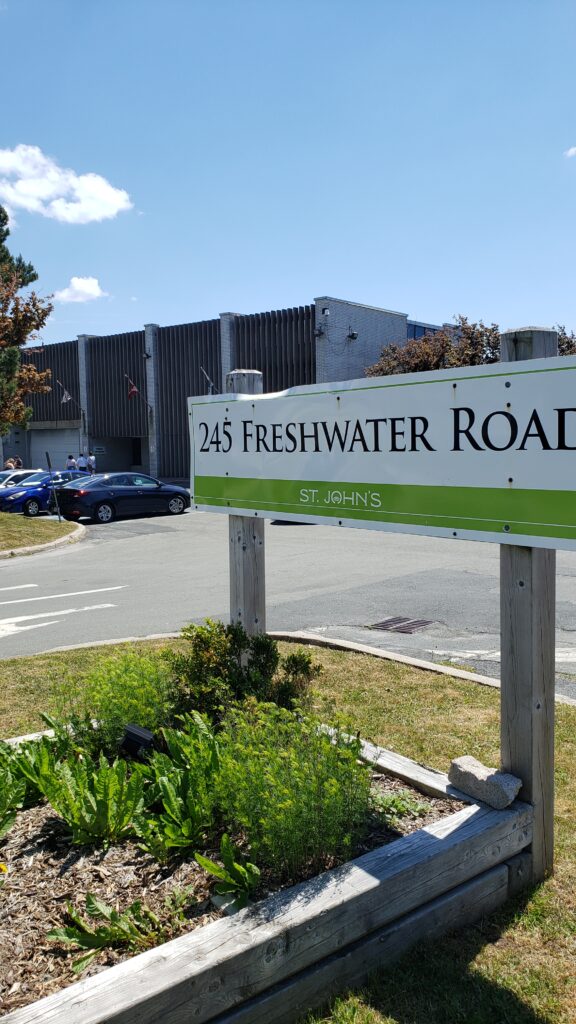The Best of St. John’s Farmers’ Market
The St. John’s Farmers Market is located at 245 Freshwater Road. The market is only open on Saturdays all year round. However, thousands of people visit the market every weekend to get fresh food, fruits and vegetables. The best time to visit and get the best produce is early morning, just before the crowded market.
There are hundreds of vendors selling a wide variety of products. Most of these products are homemade with the highest quality materials. We could smell the food in the food court from the parking lot. Our nose was tingling as we entered the building.
St. John’s Farmers Market
You can park at the right of the building or in the Revenue Canada Building Parking lot. There is enough space to park for free when you get here. We enter through a small hallway at the left of the building into a large open area with vender from all over the city, then walk over to the food court.
The Farmer’s Markets host over 30 vendors who create and sell some of the products for your personal needs. Every Saturday, this is one of the busiest places in the city to visit. Customers from all over the city come to get their goods and services. This is the best place to have lunch. You can choose from different ethnic food.
Visit The St. John’s Farmers Market
St. John’s Farmers Market
This is a Year-round Farmers’ Market. Open every Saturday from 9 to 4 pm. You can get fresh local produce here such as
- Cheeses
- Local and International foods
- Baked goods
- Crafts
- Jewellery
- Body products
- Photography or Arts
Website: Visit
Address: 245 Freshwater Road, St.John’s, NL , A1B 1B3
Facebook: Visit
Instagram: Visit
During peak summer, farmers’ markets are packed with products grown locally by farmers. Most locally grown produce is picked at the right time when they are ripe, sweet and ready to eat. You can find berries, apples, tomatoes, potatoes, and other ground vegetables and fruits. The best months to get farm vegetables are August, September and October. Newfoundland and Labrador growing season is short and starts late due to the weather. Most farmers set their crops in May and get them ready to sell at the market by August, September and October.
During your visit, you can expect to enjoy different ethnic food, local artists, baked goods and other vendors with local craft items. This is a great way to support your local community.
Travelling to Newfoundland and Labrador. Travelers also ask.

Is St. John’s, Newfoundland, worth visiting?
St. John’s, the capital, is worth visiting. St. John’s offers a rich cultural heritage, a vibrant arts scene, and breathtaking natural landscapes. Known for its colourful row houses, historic sites like Signal Hill, and picturesque harbour, St. John’s provides a unique blend of natural beauty. The city’s friendly locals, lively music scene, and excellent seafood add to its charm, making it a must-visit destination.
What is St. John’s, Newfoundland, famous for?
St. John’s is famous for several things:
- Signal Hill: This historic site offers panoramic views, and the Cabot Tower is where the first transatlantic wireless communication was received.
- George Street is renowned for its nightlife, with the most bars and pubs per capita in North America.
- Colourful Row Houses: Known as Jellybean Row, these brightly painted homes are iconic.
- Rich History: As one of the oldest cities in North America, it has a rich maritime history and cultural heritage.
How many days does it take to visit St. John’s, Newfoundland?
To fully experience St. John’s and its surroundings, a visit of 4 to 5 days is recommended. This allows time to explore the city’s historical sites, enjoy the local cuisine, enjoy the nightlife on George Street, and venture out to nearby natural attractions such as Cape Spear and Quidi Vidi Village.
Is St. John’s, Newfoundland, a walkable city?
Yes, St. John’s is a walkable city, especially in the downtown area, where many attractions, restaurants, and shops are concentrated. The city’s hilly terrain can be challenging, but it also offers beautiful vistas and charming streets to explore on foot.
What is the best month to visit Newfoundland?
The best months to visit Newfoundland are from late June to early September. The weather is milder during this period, and you can enjoy outdoor activities like hiking, whale watching, and iceberg spotting. July and August are viral for tourists.
What is the best time of year to visit St. John’s, Newfoundland?
The best time to visit St. John’s is during the summer, from June to early September. During this time, the weather is warm, and many festivals and events occur. This is also the peak season for whale-watching and iceberg viewing.
Is St. John’s Newfoundland expensive?
St. John’s can be moderately expensive, especially during peak tourist season. Accommodation, dining, and activities can add up, but budget-friendly options are also available. Compared to larger Canadian cities, St. John’s is relatively affordable.
Is Newfoundland expensive to visit?
Newfoundland is not excessively expensive to visit, but costs can vary depending on the time of year and type of accommodation. While certain activities and dining experiences may be costly, there are plenty of free or low-cost activities to enjoy.
What is the famous street in St. John’s, Newfoundland?
George Street is famous in St. John’s for its vibrant nightlife and numerous bars and pubs. George Street is a popular spot for locals and tourists looking to experience live music and socialize.
Can you get around St. John’s without a car?
Yes, you can get around St. John’s without a car, especially downtown, where many attractions are within walking distance. You’ll have access to convenient transportation options, such as public transportation, taxis, and ride-sharing services.
How long is the ferry ride from Nova Scotia to St. John’s, Newfoundland?
There is no direct ferry to St. John’s. However, you can take a ferry from North Sydney, Nova Scotia, to either Argentia (a 16-hour ride) or Port aux Basques (a 6–8-hour ride) in Newfoundland. From there, you must drive to St. John’s, which takes approximately 1.5 hours from Argentia or 9 hours from Port aux Basques.
How long does it take to drive around St. John’s?
Driving around St. John’s can take about an hour, depending on traffic and stops. Exploring the greater St. John’s area, including nearby attractions like Cape Spear and Quidi Vidi, can take several hours.
What is the crime rate in St. John’s, Newfoundland?
St. John’s has a relatively low crime rate compared to other Canadian cities. While it experiences typical urban crime, it is generally considered a safe place for residents and visitors.
How cheap is Newfoundland?
Newfoundland is relatively affordable compared to other parts of Canada. While some areas, especially St. John’s, can be expensive, smaller towns and rural areas, however, offer more budget-friendly options for accommodation and dining.
What is the best way to tour Newfoundland?
The best way to tour Newfoundland is by car. This allows you to explore the island’s diverse landscapes, remote villages, and natural attractions at your own pace. Renting a car is recommended if you’re flying into the province.
In what month do you see icebergs in Newfoundland?
Iceberg season in Newfoundland typically runs from late May to early June, though icebergs can sometimes be seen as late as July. The best month for iceberg viewing is usually June.
What is the best month to see icebergs in Newfoundland?
June is generally the best month to see icebergs in Newfoundland. This is when most icebergs drift along the coast, providing spectacular viewing opportunities.
When can I see puffins in Newfoundland?
Puffins can be seen in Newfoundland from late May to early September. The best months to see them are June and July, when they are most active during their breeding season.
What is the wettest month in Newfoundland?
October is typically the wettest month in Newfoundland, and it experiences the highest average rainfall.
When can you see whales in St John’s, Newfoundland?
Whale-watching season in St. John’s is from mid-June to mid-August. During this time, humpback, minke, and other whale species migrate through the waters of Newfoundland.
What should I pack for St. John’s, Newfoundland?
When visiting St. John’s, pack layers to accommodate varying weather conditions. Essentials include:
- Waterproof jacket and footwear
- Warm clothing (sweaters, hats, gloves)
- Comfortable walking shoes
- Sunscreen and sunglasses
- Cameras and binoculars for wildlife and iceberg viewing
Can you see the Northern Lights from Newfoundland?
You can watch the Northern Lights (Aurora Borealis) from Newfoundland, particularly in low-light pollution areas. The best time to see them is from late fall to early spring.
Where is the best place to see whales and icebergs in Newfoundland?
Twillingate and Bonavista are Newfoundland’s best places to see whales and icebergs. These coastal areas offer excellent viewing opportunities and tours.
Are there polar bears in Newfoundland?
Polar bears are occasionally seen in the northern parts of Newfoundland and Labrador, particularly in the Labrador region. They are not commonly found in Newfoundland itself.
How long does it take to drive from one end of Newfoundland to the other?
Driving from the western end of Newfoundland (Port aux Basques) to the eastern end (St. John’s) takes approximately 9–10 hours without significant stops.
Is Fogo Island worth visiting?
Fogo Island is worth visiting for its unique culture, stunning landscapes, and renowned Fogo Island Inn. It offers a distinctive experience of Newfoundland’s heritage and natural beauty.
How often can you see northern lights in Newfoundland?
The Northern Lights can be seen in Newfoundland several times a year, particularly during periods of high solar activity. The best times are during winter when nights are longer and darker.
What is the best time to see the Northern Lights?
The best time to see the Northern Lights is during the winter, from late September to early April, particularly around midnight or early morning.
How long is the ferry ride to Fogo?
The ferry ride to Fogo Island from Farewell, Newfoundland, takes approximately 45 minutes to an hour.
How much is the ferry to Fogo Island?
As of the latest information, the ferry to Fogo Island costs around $15–20 CAD per vehicle and additional fees for passengers, but prices can vary, so it’s best to check current rates.
What is so special about Fogo Island?
Fogo Island is unique for its rugged natural beauty, traditional outport culture, and the acclaimed Fogo Island Inn. It’s known for its artistic community, distinctive architecture, and stunning coastal Scenery.
Are there narwhals in Newfoundland?
Narwhals are typically found in Arctic waters and are uncommon in Newfoundland.
Are there dolphins in Newfoundland?
Yes, dolphins can be seen in the waters around Newfoundland, including species like the Atlantic white-sided dolphin and the common dolphin.
Are there killer whales in Newfoundland?
Killer whales (orcas) are occasionally sighted around Newfoundland, especially during summer.
What is Cape Spear known for?
Cape Spear is known for being the easternmost point in North America. It features a historic lighthouse and offers stunning 180-degree views of the Atlantic Ocean, making it a popular tourist spot.
Where can I see whales in Newfoundland?
Some of the best places to see whales in Newfoundland include:
- St. John’s and Cape Spear
- Trinity and Bonavista
- Twillingate
- Witless Bay Ecological Reserve
How do you see puffins in St John’s?
To see puffins near St. John’s, visit the Witless Bay Ecological Reserve island, which is home to large colonies of puffins. Boat tours from Bay Bulls can take you close to the puffin nesting sites.
How long do you need to see Newfoundland?
Plan to spend at least 7–19 days to see Newfoundland highlights. This allows enough time to explore St. John’s, the Avalon Peninsula, Gros Morne National Park, and other key attractions.
When should I go to Newfoundland?
The best time to visit Newfoundland is from late June to early September when the weather is mild. You can enjoy outdoor activities, events, and festivals. This period is also ideal for whale-watching and iceberg-viewing.
What are the top tourist attractions in Bay Bulls and Witless Bay?
Bay Bulls is known for its incredible whale-watching tours, particularly with O’Brien’s Whale and Bird Tours. Witless Bay Ecological Reserve is famous for its puffin colonies and seabird watching. Both areas also offer beautiful coastal hiking trails, such as the East Coast Trail.
Where can I go whale watching in Bay Bulls?
O’Brien’s Whale and Bird Tours is the most popular whale-watching operator in Bay Bulls. Their tours often spot humpback whales, orcas, and other marine life, providing an unforgettable experience.
What wildlife can I see in Witless Bay Ecological Reserve?
The Ecological Reserve in Witless Bay is home to the largest Atlantic puffin colony, common murres, black-legged kittiwakes, and other seabirds on the island. During certain seasons, visitors can also see humpback whales and dolphins.
How do I get to Bay Bulls and Witless Bay from St. John’s?
Bay Bulls and Witless Bay are approximately a 30-minute south of St. John’s. Take the Southern Shore Highway, directly to these coastal towns.
What are the best hiking trails in Bay Bulls?
The Spout Path and Mickeleens Path are part of the East Coast Trail network and are highly recommended for their scenic coastal views, challenging terrain, and natural beauty.
When is the best time to visit Witless Bay to watch puffins?
The best time to see puffins in Witless Bay is mid-May to mid-September. During this period, thousands of puffins nest and raise their young on the Witless Bay Ecological Reserve islands.
Are there any good restaurants in Bay Bulls and Witless Bay?
In Mobile, The Captain’s Table is well-known for its seafood dishes and delicious local cuisine in a cozy atmosphere.
What accommodation options are available in Bay Bulls and Witless Bay?
The area has several charming B&Bs and inns, such as Bread and Cheese Country Inn in Bay Bulls and Whale House Guest House in Witless Bay, offering comfortable stays and local hospitality.
What are some family-friendly activities in Bay Bulls?
Whale watching, visiting the Witless Bay Ecological Reserve, and exploring the scenic trails are great family-friendly activities. Additionally, families can enjoy picnicking, puffin watching and beachcombing along the coast.
Can you swim in the waters around Bay Bulls and Witless Bay?
The waters around Bay Bulls and Witless Bay are generally cold, even in summer, and the rugged coastline can be dangerous for swimming. However, beachcombing and exploring tide pools can be enjoyable activities.
What marine life can be seen on a boat tour from Bay Bulls?
Boat tours from Bay Bulls often encounter humpback whales, orcas, minke whales, and numerous seabirds such as puffins, razorbills, and murres. Occasionally, dolphins and sea turtles are also spotted.
Are there any guided tours in Witless Bay?
Several companies offer guided tours in Witless Bay, focusing on bird watching, whale watching, and exploring the ecological reserve. O’Brien’s Whale and Bird Tours is a notable provider.
What are the best photography spots in Bay Bulls and Witless Bay?
The rugged coastline, picturesque harbour, and wildlife offer excellent photography opportunities. Specific spots include:
- The viewpoints along the East Coast Trail.
- The harbour in Bay Bulls.
- The bird colonies in Witless Bay Ecological Reserve.
What are some nearby attractions to Bay Bulls and Witless Bay?
Nearby attractions include Cape Spear, North America’s easternmost point, and La Manche Provincial Park, known for its suspension bridge and hiking trails. St. John’s has a rich history and vibrant culture.
Is there a visitor center in Bay Bulls or Witless Bay?
While there isn’t a dedicated visitor center, local tour operators and accommodations often provide information and resources for visitors.
What are the best times of year to visit Bay Bulls and Witless Bay for outdoor activities? The summer months (June to September) are ideal for outdoor activities, offering the best weather for hiking, whale watching, and bird watching. Fall also provides beautiful foliage and fewer crowds.
Can you see the Northern Lights in Bay Bulls and Witless Bay?
While it’s not common, on precise nights, particularly in the winter months, it is possible to see the Northern Lights in Bay Bulls and Witless Bay due to their northern latitude and low light pollution.
What types of whales can you see in Bay Bulls and Witless Bay?
In Bay Bulls and Witless Bay, you can commonly see humpback whales, minke whales, and occasionally orcas. The region’s rich marine ecosystem attracts these magnificent creatures, particularly during the summer when they migrate to feed.
When is the best time to watch whales in Bay Bulls and Witless Bay?
The best time for whale watching in Bay Bulls and Witless Bay is from mid-June to mid-August. During these months, the waters teem with whales due to the abundance of capelin, their primary food source.
What is the weather like for whale watching in Bay Bulls and Witless Bay?
The weather during the whale watching season in Bay Bulls and Witless Bay is mild, with temperatures ranging 13°C to 22°C. However, it can be windy and more relaxed on the water, so dressing in layers is advisable.
How long do whale-watching tours last in Bay Bulls and Witless Bay?
Whale-watching tours in Bay Bulls and Witless Bay typically last 2 to 2.5 hours. This duration allows ample time to locate and observe the whales and enjoy the stunning coastal scenery.
Can you see puffins while whale watching in Bay Bulls and Witless Bay?
Absolutely! Puffins are a common sight in Bay Bulls and Witless Bay, especially around the Witless Bay Ecological Reserve, which hosts one of the largest puffin colonies in North America. Many whale-watching tours also include puffin viewing.
What should you wear for whale watching in Bay Bulls and Witless Bay?
For whale watching in Bay Bulls and Witless Bay, wearing layered clothing to adjust to changing temperatures, a waterproof jacket, non-slip shoes, and a hat is best.
Are whale-watching tours in Bay Bulls and Witless Bay family-friendly?
Yes, whale-watching tours in Bay Bulls and Witless Bay are family-friendly. The tours suit children, and the experience can be educational and thrilling for all ages. However, checking with the tour operator for specific age restrictions or recommendations is essential.
How close can you get to whales on a Bay Bulls and Witless Bay tour?
Tour boats maintain a respectful distance from the whales to ensure their safety and comfort. Typically, boats stay at least 200 meters away, but whales often approach boats out of curiosity, offering closer views without disturbance.
What other wildlife can you see while whale watching in Bay Bulls and Witless Bay?
Besides whales and puffins, you might see other seabirds, such as razorbills, murres, and gannets. Seals and dolphins are also frequent visitors to these waters, enhancing the overall wildlife viewing experience.
Do you need to book whale-watching tours in advance in Bay Bulls and Witless Bay?
We recommend booking whale-watching tours in advance, especially during peak season (mid-June to mid-August). This ensures you secure a spot on your preferred tour and time.
What are Bay Bulls and Witless Bay’s best whale-watching tour operators?
Some of the best whale-watching tour operators in Bay Bulls and Witless Bay include O’Brien’s Whale and Bird Tours, Gatherall’s Puffin and Whale Watch, and Mullowney’s Puffin and Whale Tours. These operators are well-reviewed for their knowledgeable guides and excellent service.
How much do whale watching tours cost in Bay Bulls and Witless Bay?
Whale-watching tour prices in Bay Bulls and Witless Bay range from CAD 60 to CAD 120 per adult. Discounts are often available for children, seniors, and group bookings.
Are whale-watching tours in Bay Bulls and Witless Bay accessible for people with disabilities?
Many whale-watching tour operators strive to be inclusive, offering boats with ramps or lifts for wheelchair access. However, contacting the tour operator in advance is advisable to ensure they can accommodate specific accessibility needs.
What safety measures exist for whale-watching tours in Bay Bulls and Witless Bay?
Safety measures include life jackets for all passengers, safety briefings before departure, experienced captains and crew, and adherence to weather advisories. Boats are also equipped with communication devices and emergency equipment.
Can you see whales from the shore in Bay Bulls and Witless Bay?
While spotting whales from the shore in Bay Bulls and Witless Bay is possible, the best views are typically obtained from a boat. However, certain coastal areas and lookout points may offer occasional sightings.
What should you bring on a whale-watching tour in Bay Bulls and Witless Bay?
Bring a camera or binoculars for better viewing, layered clothing, a waterproof jacket, sunscreen, a hat, and any personal items like motion sickness medication.
What is the Witless Bay Ecological Reserve, and why is it essential for whale watching?
The Witless Bay Ecological Reserve is a protected area known for its abundant marine wildlife, including large seabird colonies and frequent whale sightings. Its nutrient-rich waters attract whales, making it a prime location for whale watching.
Are there educational components to whale-watching tours in Bay Bulls and Witless Bay?
Many tours include educational commentary from knowledgeable guides who provide information about whale behaviour, marine ecosystems, and conservation efforts. This enhances the overall experience by adding an educational dimension.
What is the success rate of seeing whales on tours in Bay Bulls and Witless Bay?
The success rate of seeing whales in Bay Bulls and Witless Bay is very high, often exceeding 90% during peak season. The region’s rich feeding grounds and migration patterns ensure frequent sightings.
These Are The Travel Planning Resources You Should Use
Looking to book your trip to Newfoundland and Labrador? Use these resources that are tried and tested by other travellers like you who vacation in Newfoundland and Labrador. Bookmark these links. Save them for future reference.
Booking Flights, Hotels or B&B: Start planning your next vacation trip by finding the best flight, hotel or b&b deals. Book Here
Finding things to do in Newfoundland and Labrador on TripAdvisor and Viator is not hard. You can enjoy boat tours, whale watching, iceberg watching, kayaking and other activities. Book all these activities on
You can also find low prices on hotels, B&B and cabins with these two providers. If you are located in Canada, the USA, the UK or Europe, use Booking.com, and if you are in Canada, the USA or anywhere else, use TripAdvisor.
Car Rental: Here is what we recommend:
When you book with Rentalcars.com, you can compare prices and find the best vehicle for your trip. Economybookings.com Display all their vehicle on the website with a detailed description. They display high-quality photos and a user rating as well. Qeeq.com serves road trip travellers like you from different countries by working with car rental companies worldwide.
Get compensated if your flight is delayed or cancelled.
AirHelp and Compensateair will help you with flight delays, cancellations, or denied boarding. All you need to do is to submit your flight details, and they will handle the claim process on your behalf. They will handle all the paperwork, airline negotiations, and legal proceedings.
Do you need more help planning your trip?
Check out our Resources Page, where we also highlight all the resources and companies you can use to assist with your planning.












Things to do on Family Vacation in Newfoundland › Gros Morne
November 7, 2022[…] St John’s Farmers Market – Located on Freshwater Road in St John’s, this market has everything from fresh produce to […]